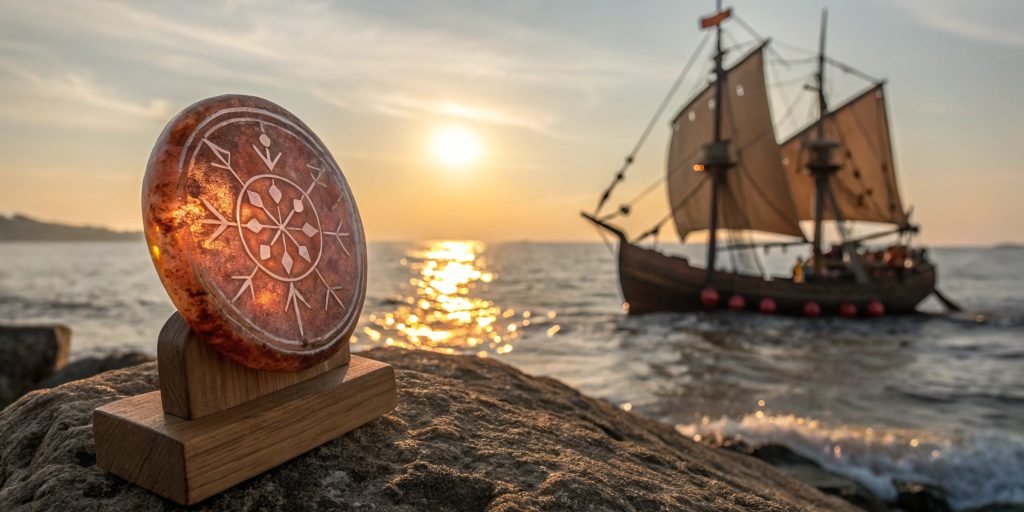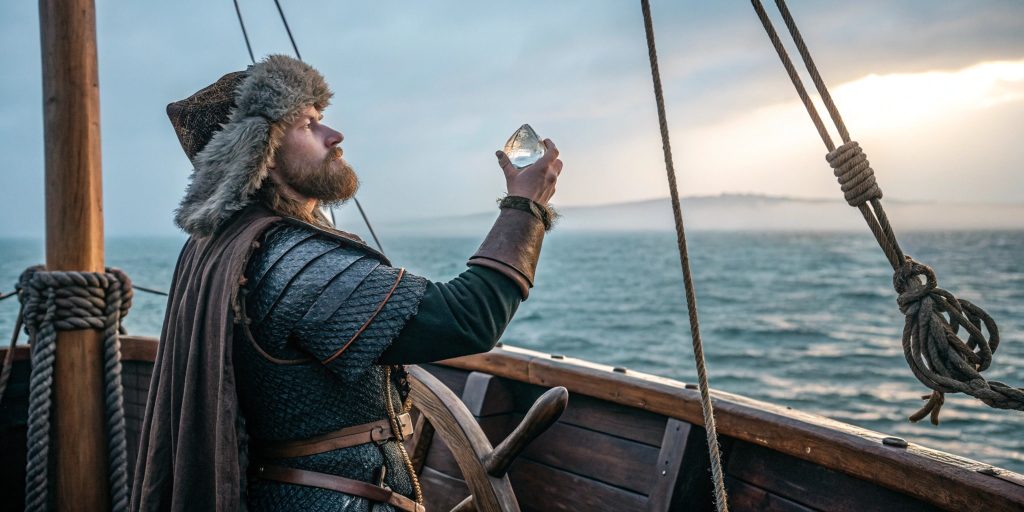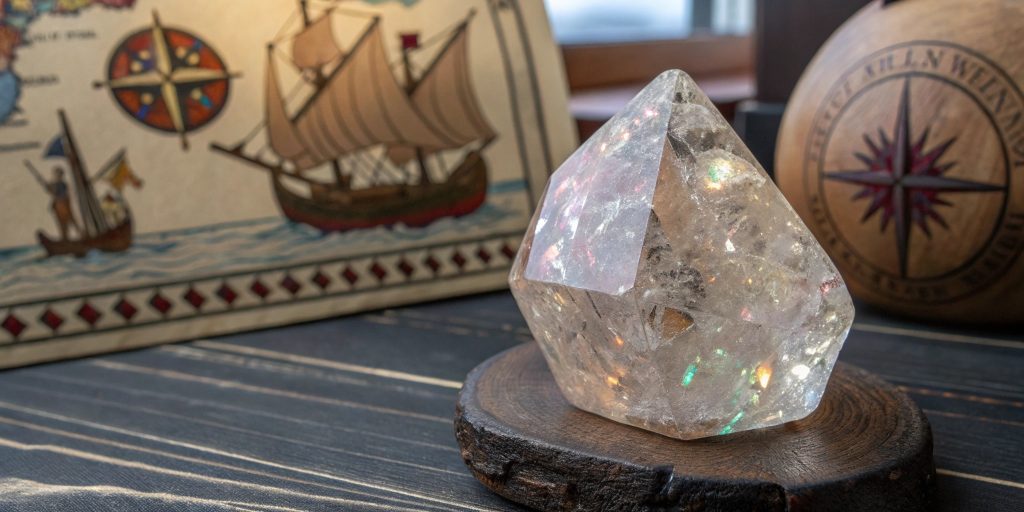Daily Life in the Viking Age, Viking Ships, Vikings
Did Vikings Navigate With ‘Sunstone’?
The Viking Age was a time of great sea exploration. Norse sailors sailed through vast, dangerous waters. They used a special crystal called the viking sunstone to find their way.
This crystal was thought to help them navigate, even when the sky was dark. Without the sun’s clear view, the sunstone was crucial. It enabled them to sail the North Atlantic with precision.
Let’s examine the sunstone’s importance in Viking navigation. We’ll explore its historical role and the science behind it.
Introduction to Viking Navigation
Viking sailors bravely sailed the North Atlantic. They used advanced ocean navigation techniques, including using sunstones to locate the sun. Their Viking ships took them to places like Iceland and Greenland.
They used the sun, stars, and nature to guide them. This helped them travel through tough waters. Their ships were known for reaching far-off lands with great accuracy, aided by their ability to locate the sun.
Their navigation skills were key to their success. Without them, the Vikings might not have explored so much. Their ships and navigation methods are still fascinating today.
The Myth and Mystery of the Viking Sunstone
Many have been interested in the sunstone. It’s tied to the stories of Norse explorers, and people say it was a magical tool for Viking sailors.
Stories tell of Vikings using sunstones to find the sun on cloudy days. This improved their sailing, particularly in the challenging waters around Icelandic coasts. It shows that they knew a lot about nature.
The Viking sunstone compass legend shows the Vikings’ love for adventure. As they sailed more, stories about the sunstone grew. It became a symbol of their bravery and skill.
What is a Viking Sunstone?
The Viking sunstone was key for ancient sailors, helping them navigate the latitude of their journeys. It’s a special calcite crystal that helps locate the sun, even when clouds hide it, essential for navigating the latitude of the North Atlantic. This skill was crucial for Viking explorers.

What Is a Viking Sunstone Made of?
The Viking sunstone is made mainly of optical calcite and linked to Iceland’s spar. Calcite crystals bend light, helping locate the sun even when it’s cloudy.
Different Types of Sunstones
There are many kinds of sunstones, each unique. Iceland spar is the most famous for its clearness and light-bending abilities. Other sunstones are less clear but still useful for finding the sun. Knowing about these differences helps us understand how Vikings navigated their long sea trips.
Viking Sunstone: How it Works in Navigation
The Viking sunstone is a clever tool for finding your way, especially in bad weather. It uses the science of polarization to help sailors on the sea.
Understanding Polarization
Polarization means light waves go in one direction. The sunstone can spot the sun’s position, helping sailors navigate even when it’s cloudy. By adjusting the calcite crystal, they can find the sun’s light even on the most overcast days.
This skill is key for locating the sun through clouds using advanced techniques like sunstones.
Using the Sunstone Crystal as a Compass
The sunstone acts like a compass. When held right, it shows the sun’s direction. This helped Vikings navigate safely over long, dangerous seas, using sunstones to locate the sun.
Historical Evidence of Viking Sunstone Use
Solid evidence supports the Viking sunstone’s role in navigation, particularly the ability to find one among Viking artifacts. This evidence comes from many sources, including ancient texts, which give us a glimpse into how the Vikings used this tool at sea.
Literary References to Viking Navigation Tools
Old texts are full of clues about Viking navigation. For example, the “Hrafns Saga” discusses how the Vikings used sunstones to guide their ships. King Olaf’s stories also hint at the Vikings’ advanced navigation methods, possibly including the use of sunstones to locate the sun, as noted in the proceedings of the royal society.
Archaeological Findings and Their Significance
Recent digs have found sunstone-like crystals in Viking shipwrecks, believed to have been used for navigation, yet no sunstone of equal significance has been found. These finds show how important these tools were for navigation, especially the sunstone among Viking shipwrecks or settlements. They help us understand how Vikings sailed the oceans, linking their stories to real-life tools.
The Science Behind the Viking Sunstone Crystal
The science of Viking sunstone is fascinating. It has optical properties that help with navigation in tough conditions. Certain crystals’ birefringence splits light into two rays, helping find the sun’s position, even when it’s hidden by clouds or at twilight.

Scientists study the crystal’s refractive properties. They figured out how Vikings used sunstone for navigation. By analyzing polarized light, sailors could find their way, even when it was hard.
Learning about these optical properties shows how smart the Vikings were. They used sunstone to guide their ships, not just luck. Today, we still learn from their clever ways of navigating.
Comparison with Other Navigation Tools
Viking navigation tools worked differently in different conditions. The sunstone was special compared to tools like the magnetic compass. It shows how clever Viking navigators were.
Magnetic Compass vs. Sunstone
The magnetic compass uses the Earth’s magnetic field to show direction. It works well when you can see the horizon, but it’s not good in cloudy or foggy weather.
Conversely, the sunstone helps find the sun’s position even when it’s cloudy, making it a great choice in bad weather. The sunstone was a smart choice for Viking navigators.
The Role of the Kollsman Sky Compass
The Kollsman Sky Compass was made later. It uses the sun and stars to find direction, which is great for flying high. It’s like the sunstone, but for the sky, it assists in determining latitude during cloudy days.
The Sunstone and the Kollsman Sky Compass show how good Viking navigators were. They made tools that helped them navigate in many ways.
Viking Sunstone and Overcast Conditions
Viking sailors were amazing at navigating through tough weather, especially using the sunstone among Viking shipwrecks. They could sail even when it was cloudy and dark. The Viking sunstone compass was a key tool that helped them find the sun, even when hidden.
Navigating in Cloudy and Twilight Conditions
Viking sailors faced big challenges when the sky was cloudy. The sunstone helped them find the sun’s direction, which was important because it allowed them to keep sailing, no matter the weather.
Finding the Sun When It’s Hidden
Even when the sun was completely hidden, the sunstone was a game-changer. It helped sailors find the sun’s direction, even in cloudy or dark conditions. This skill was crucial for their sea journeys and showed how important the sunstone was to the Vikings, particularly in locating the sun during overcast conditions.

